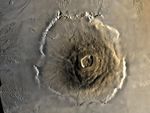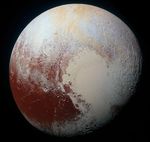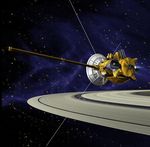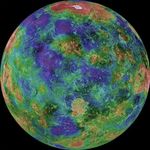Solar System 2019 - UD Physics
←
→
Page content transcription
If your browser does not render page correctly, please read the page content below
Solar System 2019
Earth’s moon and other rocky
bodies of our solar system
Scott Jackson, Mt. Cuba Astronomical
Observatory (and Planetarium)
Help session:
Sunday afternoon: March 3, 2019 at Mt Cuba
Observatory
Test on March 16, 2019
“Two 8.5 x 11 inch two sided sheet”
Test will include questions about a series of
images projected onto the front of the room. 1EVENT DESCRIPTION
demonstrate an understanding and knowledge of the geologic
characteristics and evolution of the Earth’s moon and other rocky
bodies of the solar system
DwarfPlanets: Pluto, Ceres, Haumea, Makemake, Eris .
Satellites: Earth’s Moon,Charon, Mimas, Phoebe
General Details of Other Small Bodies: Asteroid Belt,Centaurs, Trojans,
Trans-Neptunian Objects
Specific Details of: ‘Oumuamua and (225088) 2007 OR10
Missions: New Horizons, Dawn, Cassini, Lucy, Voyager 2
History and formation processes
Remote sensing, imagery and satellite measurements
Kepler’s laws, gravitational effects of the moon and tides
Rotation, libration, phases, and eclipses
Surface Dating, volcanism & weathering, cratering & impact
processes
Internal, surface, and Atmospheric compositions
3Our sun’s evolutionary stages
• Gas and dust compress under self gravitation
• Any rotation in the gas cloud is conserved (and
causes planets to revolve and rotate)
•A protostar star is form
• As the gas is compressed by gravity, the core of the
protostar increased in pressure and temperature
until nuclear fusion occurs: Hydrogen Helium
The star becomes stable and stays this way our
sun
4History and Formation of the Solar System
The planets of the Solar System formed from a nebula of
gas, dust, and ices coalescing into a dusty disk around the
evolving Sun.
Within the disk, dust grains and ices coagulated into
growing bodies called planetesimals.
These then collided and were swept up together to form the
planets and their satellites
The fact that all planets revolve around the sun in the same
direction and most rotate in the same direction shows the
left over energy from the initial collapse of the nebula. 5Early solar system evolution
Early in the sun’s life (as the planets were forming), the
sun had a very strong solar wind (from flares)
Charged particles streaming out of the suns atmosphere
This solar wind was produced as the nuclear reactions in the
core of the sun started.
The sun produces a weaker solar wind today that fluctuates with
the sunspot activity of the sun – more sunspots, more solar wind.
Solar wind “storms” cause the Northern Lights (auroras)
This early strong solar wind and collisions between
particles helped to “pushed” much of the material that
had not been formed into planets out to the farther
reaches of the solar system
This helped formed the Kuiper Belt and the Oort Cloud (the
source of long period comets)
6The end of our solar system • The planets form about the same time as the sun. • At the end of our suns normal life, hydrogen is depleted in the core of the sun. Gravity takes over and causes the core to heat up further. • BUT fusion continues in a shell outside the core. Our sun will “bloat” up to a red giant. The earth will be fried • Helium will start to be fused to carbon in the core of our sun. • •The sun will be convulsed and throw off half its mass as a planetary nebulea -- solar system destroyed • A white dwarf (carbon) star will be left behind 7
Objects of the Solar System: Planets
A planet is … in orbit around the Sun,
Has sufficient mass to assume a hydrostatic equilibrium (nearly round)
shape, and
Has “cleared the neighbor-hood” around its orbit.
8Dwarf Planets
A dwarf planet is … Pluto (spherical with 1 moon- Charon)
In orbit around the Sun Ceres
Has sufficient mass for Ceres is the largest asteroid in the main asteroid
its self-gravity to belt. It is a dwarf planet because of its round
overcome rigid body shape
forces so that it Rocky (high density)
assumes a hydrostatic
In asteroid belt
equilibrium (nearly
round) shape, Between Mars &
Has not “cleared the Jupiter
neighbor-hood” around
its orbit, and
Is not a satellite of a
planet, or other
nonstellar body.
Haumea
Dwarf planet beyond Neptune, About the size of Pluto
with 2 moons, fast rotation rate
Collision likely caused it to rotate so fast and to form
its 2 moons – Kuiper belt object Ceres
9o Dwarf Planets
Remarkably complex geology –
Surface is 98% frozen nitrogen plus a little methane and
carbon monoxide
New (No craters) and old (cratered) surfaces next to each
other
Nitrogen ice glaciers
Ice water mountains
Possible cryovolcanoes Water ice
glacier on
Earth
Nitrogen ice
glacier on
Pluto
Ceres
1011
12
Atmosphere on Pluto – very thin ~ 0.00001 atmosphere
Nitrogen, methane, particles (causes haze),
13Dwarf Planets
Makemake Dwarf plant beyond Pluto
It and Haumea and Eris are responsible for demoting Pluto to a dwarf planet
No close up pictures
870 miles in diameter, no atmosphere
Takes 310 years to go around the sun, in the Kuiper belt
Frozen layer of methane and possibly ethane and nitrogen
One moon
Eris About the same size as Pluto
No close up pictures
1400 miles in diameter – a little smaller than our moon.
Takes ~5 hours for sunlight to reach Eris.
557 years to orbit the sun
In the Kuiper belt
One very small moon – allows astronomers to determine the mass of Eris
Ceres
14 Some 7000 asteroids
Asteroids have been identified so
far.
Most are in a belt or
band between the
orbits of Jupiter and
Mars
Jupiter probably
stopped planetisimals
asteroid Gaspra formed at the birth of
the solar system from
Why is Gaspra not a
dwarf planet and Ceres coalescing into a
is ? planet. 15 The Kuiper Belt is made up of
Kuiper Belt & Oort cloud millions of icy and rocky objects
that orbit our Sun beyond the orbits
of Neptune and Pluto.
These are planetesimals that did
not combine to make planets.
It is the source of short period
comets
Oort Cloud is spherical and is at
the outer edge of our solar system
It was pushed out there at the start
of the solar system by strong solar
winds and by the gravity of the
large gas giant planets
The Oort cloud acts as a reservoir
for the long-period comets
16Charon Biggest moon of Pluto.
Half the size of Pluto double dwarf system
New Horizon’s fly by
Orbits Pluto every 6.4 days
Mimas -- moon of Saturn
Cassini space craft image.
246 miles in diameter – smallest spherical body
known
Mostly water ice (same density as water)
Giant impact crater
Not as big as Titan, the largest moon of Saturn
Tidally locked like the Earth’s moon. 17Phoebe another moon of Saturn
Cassini probe took this close up
Picture
Roughly 120 miles in diameter
Orbits Saturn every 18 months
Likely a “captured” object
May be a captured Centaur
asteroid – material from the
beginning of the solar system
Centaur asteroids
18Centaur A cross between asteroids and comets
Across the orbit of Neptune
Considered very old and likely
composed of material from the
beginning of our solar system
19Asteroid Belt
The heaviest
concentration of
asteroids is in a
region lying
between the orbits
of Mars and
Jupiter called the
asteroid belt.
20Facts about the Asteroid Belt
Traveling through the
The total weight of all asteroid belt in a space
the asteroids in the ship would not be like
asteroid belt is about what you see in a
1/35th of that of our science fiction film.
moon!
In addition to the belt
Ceres, the largest asteroids, there are
asteroid (a dwarf others classes of
planet), is about 1/3 the asteroids based upon
total weight of all the their location and orbit
asteroids! in the solar system:
Even though there are Apollo (Earth crossing),
a lot of asteroids, the Amors, Atons, Trojan
asteroid belt is mostly (along the orbit of
empty space. Jupitor) and Centaurs.
21Oumuamua
The first and only
interstellar object that
travel through our solar
system in 2017
Its very high speed
proved it came from
outside our solar
system
Its changing light output
indicates that it is very
long like a cigar.
22225088 2007 OR10
Binary object (a dwarf
planet with a moon)
beyond the orbit of
Neptune (Trans
Neptunian)
780 miles in diameter
Largest unnamed
object in our solar
system
Slightly larger than
Charon
Discovered in 2007
23Missions
New Horizons
• Interplanetary space probe.
• Launched in 2006
• Primary mission: Flyby Pluto and later
a Kuiper belt object (Ultimate Thule)
• Detected “hydrogen wall”
(a region of hot hydrogen at the edge of
the solar system where the solar wind
Hits the interstellar
wind)
24Missions -- Dawn
• Ion propulsion used to go to the
asteroid belt and observe Ceres (a
dwarf planet) and Vesta
• First to orbit two different targets
• Current in a uncontrolled orbit around
Ceres.
• It ran out of fuel
25Missions:Cassini -Huygens
• Probe sent to study Saturn
• Huygens probe attached to Cassini was
dropped to the surface of Titan
• Many crossings of the ring system
• Purposely flown into Saturn to burn up to
avoid any possibility of contaminating
Saturn’s moons
26Missions -Lucy
• To be launched in about 3 years
• Explore the Trojan asteroids
• Trojans believed to be remnants of
the early solar system that became
locked into Jupiter’s orbit and low
energy points.
27Missions:Voyager 2
Launched in 1977
Only probe to fly by Uranus and
Neptune
Crossed the heliopause into interstellar
space
Remains an active mission to measure
the interstellar media.
28Accepted theory of the Origin of
our moon…
• A small planet named
“Theia” slammed into earth
• It may have side swiped the
earth, created the moon,
and Theia was thrown out
of the solar system
• OR it blew apart the earth
making the combined
Earth+Theia into the Earth-
moon system.
29Evidence that Theia is part of the
Earth – moon system
• Ratio of oxygen isotopes provides a unique
signature to each planet in our solar system
– Oxygen normally has 8 protons and 8 neutrons
That is called 16O
– Some oxygen has 8 protons plus 9 neutrons or
10 neutrons –Called 17O to 18O
– Ratio of 16O to 17O to 18O is the same in the
earth and the moon
– Indicates that they were made from the same
material = Theia+ the original Earth
30More Evidence for the impact
origin of our moon
• Earth has a iron core – source of our
magnetic field
• Moon does not – any iron in Theia merged
with earth’s iron core.
– The material thrown off during the collision
would have been less dense.
• The moon is the largest moon relative to the
planet it is orbiting
– A substantial amount of material would have
been thrown off from the collision – making a
31
large moon.Estimating apparent age of
surfaces
• Crater density
• Which is older?
32Tidal effects on Earth (and our moon)
Tidal Effects
The gravity of our sun and our moon yanks the near side of
the oceans to form a high tide.
Gravity also tugs at the (solid) earth away from the oceans
on the far side. Hence high tides on the far side!
Our moon "solid ground" also has tides – very small
Tides also occur in
the crust – causing
frictional heating like
IO
33Tidal effects on Earth (and our moon)
1. A long time ago… The tidal forces of Earth on the Moon
slowed down the rotation of the Moon (while speeding up the
rotation of the Earth).
2. The Moon eventually keeps the same face toward the Earth,
becoming tidally locked (as it is now)
3. The tidal forces of the Moon on the Earth slow down the
rotation of the Earth, while speeding up the orbital motion of
the Moon
4. The Moon spirals away from the Earth, increasing its angular
momentum, compensating for the lost angular momentum of
the Earth rotation.
5. The Earth eventually keeps the same face toward the Moon,
becoming tidally locked.
6. The system stops evolving and remains in this configuration
forever (except as influenced by external forces). 34Tidal effects on Tidal Effects
The gravity of Jupiter and
satellites its large moons yank its
satellite Io every which
way.
Io’s "solid ground" tides are
more than five times as
high as Earth’s highest
ocean tides!
This causes a lot of friction
and heating of the crust of
Io
This causes sulfur
volcanoes across the face
of Io
35Lava (Basalt) filled ancient craters to form the Mare
(Seas)
Our Moon
Lots of
craters –most
from impacts
36But mare on the moon not like
volcanoes on Earth
• Mare mostly
caused by the
process that
formed the moon
• There are
volcanoes on the
moon that likely
formed like that on
Earth (next slide)
• All now extinct
37Cross section of our moon
Essentially dead – no plate techtonics
(like the earth). No strong magnetic field
(no large molten iron inner core)
38We all know about solar eclipses (yes?)
• The moon
completely blocks
out the sun’s light in
a very small spot on
Earth.
• August 21st
39• Here is what it looks
like if you were
standing near the
sun (HOT!!) and
looking through a
telescope.
4041
42
Partial Solar Eclipses
If the penumbra passes over you, only part of the Sun's
surface will be blocked out.
You will see a partial solar eclipse, and the sky may dim
slightly depending upon how much of the Sun's disc is
covered.
Partial Solar Eclipse
43 In some cases, the moon is far enough away in its orbit that the
umbra never reaches the Earth at all. In this case, there is no
region of totality, and what you see is an annular solar eclipse.
In an annular eclipse, only a small, ring-like sliver of light of the
Sun’s disk is visible. ("annular" means "of a ring").
Annular Solar
Eclipse
44Lunar
Phases
45But… did you know that you can “see”
(barely) the “dark” side of the moon
during a total solar eclipse
• But how can that
be???!!
• The earth reflects a
lot of light back to
the moon – like ~10x
that of a full moon.
• So there is enough
sunlight reflected off
the earth to
illuminate the “dark”
side of the moon!!!46We all know about Lunar eclipses
(yes?)
• The Earth completely
blocks out the sun’s
light falling on the
moon.
• BUT – the whole
moon can be
darkened – why?
• Jan 31, 2018
• Jan 20/21, 2019
47What does a lunar eclipse look like
from the surface of the moon?
• Like this!!!!
• The size of the earth,
appears to be much
larger than the sun
as viewed from the
moon…
• So… it completely
blocks the sun out
when there is a lunar
eclipse.
48From the surface of the moon, the
Earth appears to go through phases…
just like the moon…
• So… What phase is the
moon when the Earth is
“full”????
49We always see the same face of the moon…
But actually can see more than half of the moon…
Libration – or apparent wobble of the moon.
The moon appears to “wobble” up and down and left
to right a little
50We always see the same face of the moon…
What do you think the earth looks like from the
moon?
Click here
51After a really long time, a rectangle is formed…
This is due to the Moon’s rotation rate is
slightly out of sync with its orbital rate around
the earth
This is due to the Moon’
tilt of its axis
This is also the wobble from
before
52Mars
53Mars
• Gigantic volcanoes – Olympus Mons is the
largest found in the solar system
– Would cover the state of Arizona
– Similar composition to volcanoes on Earth
– None active
– No current magnetic field on Mars means no molten
core to drive active volcanoes.
– But Mars had a molten core in the past that
54
produced these volcanoesGlobal Mars mosaic from Mars surveyor
(http://www.msss.com/mars_images/moc/7_19_99_f
ifthMars/01_daymap/moc2_143_msss_2.jpg)
North polar cap at top, Volcanoes to left, Enormous rift
valley left of center, clouds, craters at bottom
55Olympus Mons
(http://www.solarviews.com/raw/mars/olympus.gif)
Huge shield volcano
The largest in the solar system
But no clear evidence of plate techtonics
56Mars North Polar Cap from Mars surveyor
(http://www.msss.com/mars_images/moc/may_2000/n_pole/npole_50.jpg)
Extremely cold temperature,
The white stuff is frozen carbon dioxide not water
but ….
Ice water is
under this
57Reflected Radar mapping of what is under the
pole
Ice layers
Base rock
Shallow Radar instrument on NASA's
Mars Reconnaissance Orbiter for mapping
underground ice-rich layers of the north
polar layered terrain on Mars
The penetrating radar reveals icy layered
deposits overlying a base rock.
58Mars South Polar cap
• Photos from Mars Global
Surveyor
• The bottom photo was taken
during summer. This is
essentially “permafrost” that is,
it does not go away.
• CO2 frost grows much larger
during winter.
• Picture taken by Mars Global
Surveyor
http://www.nasa.gov/centers/ames/multimedia/images/2005/marscap.html 59Evidence for glaciers on Mars
• Glaciers are largely restricted to
latitudes above 30° latitude. Based on
models of the Martian atmosphere, ice
should not be stable at the surface near
the equator. Glaciers near the equator
must be covered with a layer of rubble
or dust preventing the sublimation of the
ice into the atmosphere.
A terminal moraine is in the rectangle.
http://en.wikipedia.org/wiki/File:Wide_view_of_glacier_showing_image_field.JPG
60More evidence for glaciers on Mars
• http://en.wikipedia.org/wiki/File:ESP_028352_2245glacier.jpg
61Valles Marineris A gigantic rift valley 62
Mars interior – was molten iron – had a magnetic
field that has since disappeared when solidified
63Mars moons
• Geologically inactive. Captured asteroids.
• Not large enough to have enough gravity to
make them spherical.
64Venus
• Dense atmosphere / completely clouded over
– Run away greenhouse heating – very hot surface
temperatures
– Can’t easily “see” the surface but….
Radar used to “see” the surface.
• Radar has seen evidence of lava flows and
volcanism 65• Radar images of Maat
Venus Mons
• Unclear if it is an active
volcano
• Probably formed like
those on Earth & Mars
• No craters
• But no clear evidence
of plate techtonics
66No magnetic field –very slow rotation rate and lack of
internal movement of conductive material that can create a
magnetic field
67Mercury
• No air
• First satellite pictures showed a surface a lot like the
moon
• Very hot on the sun side (melts lead)
• Very cold on the shady side
• “Inferior” planet
• Show phases like the moon
• But very difficult to see – always close to the sun
• BUT recent satellite images suggest…. Extinct
Volcanoes!
68Tectonic activity on Mercury
• Over thrust
faults caused by
contraction of
mercury when
cooled
69Cross section of Mercury
Molten core should create a strong magnetic field
There is a magnetic field but 200x weaker than
Earths..
70Jupiter Largest planet Rotates every 6 hours, appears “flattened” Gas giant, would “float” on water Visible in a pair of binoculars Four major moons The closest to Jupiter is Io Many sulfur volcanoes Caused by the friction heating from the strong tides produced from Jupiter’s gravity. Totally different than Earth, Moon, Mars, Venus or Mercury 71
Io and sulfur volcanoes Tidal Effects
Io shows the same face to
Jupiter – gravitationally
locked (like our moon)
72Structure of Io
• Determined using Galileo spacecraft.
• Low density crust 20-30 miles (grey)
• Molten magma “ocean” -- red brown & orange(source of
volcanoes)
• Io’s magma ocean is
very conductive and
deflects the Jupiters
strong magnetic field
lines (blue)
• Iron and iron sulfide core
(silver)
73Ceres:
• the largest asteroid and the only dwarf planet in the inner Solar System,
orbiting in the asteroid belt between the orbits of Mars and Jupiter. It is a
rock–ice body 950 km (590 mi) in diameter and the smallest identified dwarf
planet. It surface is probably a mixture of water ice and various hydrated
minerals such as carbonates and clay minerals. It appears to be
differentiated into a rocky core and icy mantle, and may harbor an ocean of
liquid water under its surface,
Hubble space telescope
image 74Planetary Motions: Rotation
A planet or dwarf planet or asteroid will rotate
on an axis. Its rate of rotation gives the
length of a “day” on the object.
75Kepler’s First Law of Planetary Motion
The path of the planets about the sun are
elliptical in shape, with the center of the sun
being located at one focus. (The Law of Ellipses)
76Kepler’s Second Law of Planetary
Motion
The line joining a planet to the Sun sweeps out equal
areas in equal times as the planet travels around the
ellipse.
77Kepler’s Third Law of Planetary
Motion
The square of the total time period (T) of the
orbit is proportional to the cube of the average
distance of the planet to the Sun (R). (The Law
of Harmonies)
78You can also read



























































